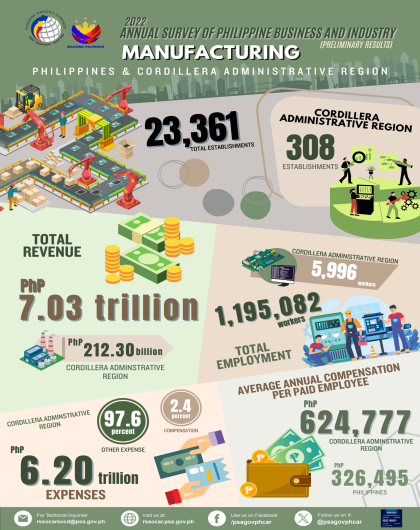The Annual Survey of Philippine Business and Industry (ASPBI), one of the designated statistical activities of the Philippine Statistics Authority (PSA), generates essential statistics for economic planning and analysis. It is specifically designed to collect and generate information on the levels, structure, performance, and trends of economic activities of the formal sector of the country’s economy.
The 2020 ASPBI is the 48th in the series of annual surveys of establishments in the country. It was conducted nationwide in April 2021 with 2020 as reference period. In this round of the ASPBI, the 2020 Survey of Tourism Establishments in the Philippines (STEP) is a rider to this survey.
This Special Release discusses the performance of the Agriculture, Forestry and Fishing Sector which includes the exploitation of vegetal and animal natural resources, comprising the activities of growing crops, raising and breeding of animals, and harvesting of timber and other plants, animals or animal products from a farm or their natural habitats.
Majority of establishments in agriculture, forestry, and fishing sector are engaged in animal production industry
In 2020, the Annual Survey of Philippine Business and Industry (ASPBI) final results showed that 2,514 establishments in the formal sector of the economy were engaged in agriculture, forestry, and fishing activities. This showed a decrease of 9.8 percent from the recorded 2,787 establishments in 2019.
Among industry groups, animal production recorded the highest number of establishments with 1,141 establishments (45.4 percent). This was followed by growing of non-perennial crops 391 establishments (15.6 percent) and support activities to agriculture and post-harvest crop activities with 356 establishments (14.2 percent).
Meanwhile, plant propagation, silviculture and other forestry activities, support services to forestry, and logging recorded less than one percent of the total number of establishments engaged in agriculture, forestry, and fishing activities. Specifically, logging recorded the lowest number of establishments with only three establishments (0.1 percent).
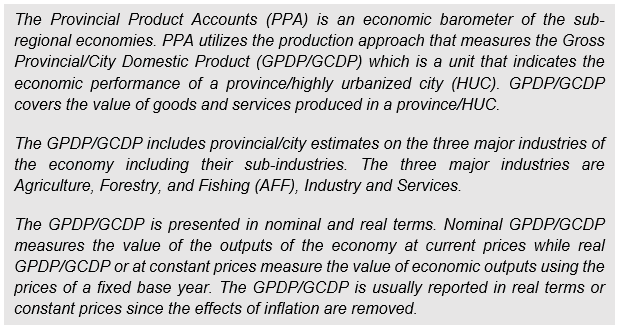
By region, CALABARZON registered the highest number of establishments engaged in agriculture, forestry, and fishing activities with 357 establishments (14.2 percent). This was followed by Western Visayas and Central Luzon with 324 establishments (12.9 percent) and 321 establishments (12.8 percent), respectively. On the other hand, Cordillera Administrative Region (CAR) registered the lowest number of establishments with only 15 establishments (0.6 percent).
Growing of perennial crops employs about 39%
A total of 138,977 workers were employed in the agriculture, forestry, and fishing sector in 2020. This was 3.9 percent higher from the recorded 133,802 workers in 2019. Of which, 137,166 workers or 98.7 percent of the total employment were paid employees while the remaining 1,811 workers or 1.3 percent were working owners and unpaid workers.
Among industry groups, growing of perennial crops had the highest number of total employment with 53,992 workers (38.8 percent). This was followed by animal production and growing of non-perennial crops with 37,635 workers (27.1 percent) and 21,499 workers (15.5 percent), respectively.
Davao Region had the highest employment with 39,444 workers (28.4 percent), followed by Western Visayas with 16,124 workers (11.6 percent), and Northern Mindanao with 15,322 workers (11.0 percent).
By ratio, the agriculture, forestry, and fishing sector posted an average employment of 55 workers per establishment. This showed an increase of 14.6 percent from the posted average employment of 48 workers per establishment in 2019.
Growing of perennial crops posted the highest average employment with 184 workers per establishment among all agriculture, forestry, and fishing industry groups. Among regions, Davao Region posted the highest average employment with 131 workers per establishment. CAR posted the lowest average employment with 10 workers per establishment.
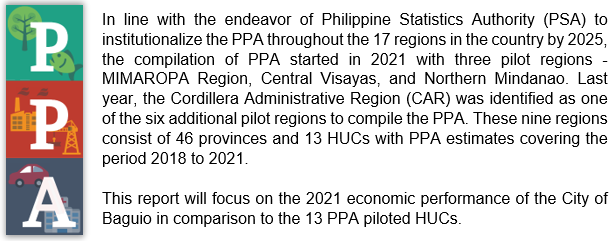
Total revenue in agriculture, forestry and fishing up by 20.2%
Establishments engaged in agriculture, forestry, and fishing activities generated a total revenue of PhP 303.1 billion in 2020, which was 20.2 percent higher than the recorded total revenue in 2019 with PhP 252.2 billion.
Among industry groups, 41.7 percent or PhP 116.3 billion of the total revenue were from establishments engaged in animal production activities. Establishments involved in growing of perennial crops and fishing activities generated the second and third highest revenue with PhP 120.2 billion (39.7 percent) and PhP 19.2 billion (6.3 percent), respectively. Logging generated the lowest revenue with only PhP 8.3 million (0.003 percent).
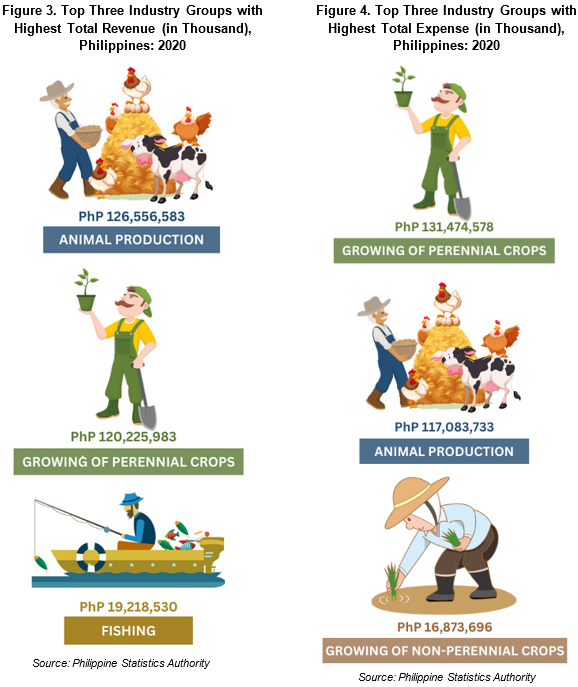
Similarly, expenditures for the agriculture, forestry, and fishing industries increased by 33.2 percent from PhP 225.1 billion in 2019 to PhP 299.7 billion in 2020. By industry groups, growing of perennial crops with total expenses of PhP 131.5 billion (43.9 percent), animal production with PhP 117.1 billion (39.1 percent), and growing of non-perennial crops with PhP 16.9 billion (5.6 percent) were the top spenders in 2020.
Across regions, Northern Mindanao generated the highest total revenue and total expense with PhP 70.7 billion (23.3 percent) and PhP 81.8 billion (27.3 percent), respectively. This was followed by Davao Region with total revenue of PhP 57.4 billion (18.9 percent) and total expense of PhP 54.1 billion (18.0 percent). Central Luzon ranked third with total revenue of PhP 51.4 billion (17.0 percent) and total expense of PhP 46.1 billion (15.4 percent). CAR generated the lowest total revenue and total expense with PhP 78.7 million (0.03 percent) and PhP 70.7 million (0.02 percent), respectively.
Support services to forestry industry group generates the highest revenue per expense ratio
By revenue per expense ratio, activities in agriculture, forestry, and fishing industries recorded a decrease of 9.8 percent from 1.12 ratio in 2019 to 1.01 ratio in 2020. This means that for every peso spent in 2020, the agriculture, forestry, and fishing industries generated an income of PhP 1.01.
Support services to forestry industry group posted the highest revenue per expense ratio of 1.52 followed by fishing with revenue per expense ratio of 1.16 and support activities to agriculture and post-harvest crop activities with revenue per expense ratio of 1.13.
By region, Central Visayas posted the highest revenue per expense ratio of 1.28. Ilocos Region and Bangsamoro Autonomous Region in Muslim Mindanao (BARMM) both ranked second with revenue per expense ratio of 1.19. National Capital Region (NCR) ranked third with revenue per expense ratio of 1.18. Establishments in CAR generated a revenue per expense ratio of 1.11.
Average annual compensation per paid employee increases by 13.5%
The average annual compensation per paid employee in the agriculture, forestry, and fishing section increased by 13.5 percent from an average annual compensation of 159,945 per paid employee in 2019 to PhP 181,581 in 2020.
Among industry groups, growing of perennial crops posted the highest average annual compensation per paid employee with PhP 208,690. This was followed by animal production and aquaculture with PhP 205,764 and PhP 175,575, respectively. Plant propagation posted the lowest average annual compensation per paid employee with PhP 68,770.
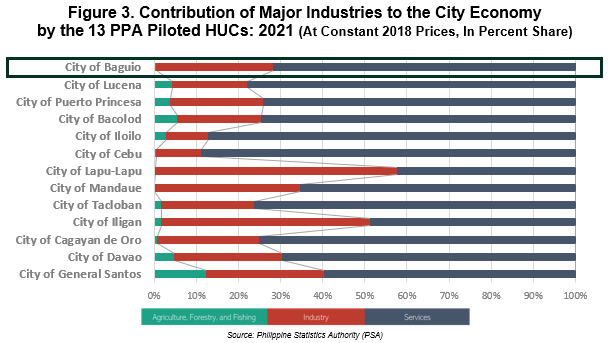
By region, CALABARZON posted the highest average annual compensation per paid employee with PhP 336,480. This was followed by NCR with PhP 289,305 and Central Luzon with PhP 254,945. CAR had average annual compensation of PhP 120,688 per paid employee.
Subsidies in the agriculture, forestry, and fishing sector decreased by 94.6%
The total subsidies amounting to PhP 21.3 million was received by the agriculture, forestry, and fishing sector in 2020. This was 94.6 percent lower from the subsidies received amounting to PhP 394.7 million in 2019.
Among the industry groups, growing of perennial crops (PhP 7.9 million), aquaculture (PhP 4.5 million), support activities to agriculture and post-harvest crop activities (PhP 4.2 million) received the highest amount of subsidies from the government.
Meanwhile, establishments engaged in plant propagation, logging, support services to forestry, and fishing industry groups did not receive any subsidies from the government.
(SGD)
VILLAFE P. ALIBUYOG
Regional Director
_________________________
TECHNICAL NOTES
Establishment is defined as an economic unit under a single ownership or control which engages in one or predominantly one kind of economic activity at a single fixed location.
Agriculture, Forestry and Fishing (Section A of the 2009 Philippine Standard Industrial Classification) includes the exploitation of vegetal and animal natural resources, comprising the activities of growing crops, raising and breeding of animals, harvesting of timber and other plants, animals or animal products from a farm or their natural habitats.
Growing of non-perennial crops includes the growing of plants that do not last for more than two growing seasons. Included is the growing of these plants for the purpose of seed production.
Growing of perennial crops includes the growing of plants that last for more than two growing seasons, either each season or growing continuously. Included is the growing of these plants for the purpose of seed production.
Plant propagation includes the production of vegetative planting materials including cuttings, suckers and seedlings for direct plant propagation or to create plant grafting stock into which selected scion is grafted for eventual planting to produce crops.
Animal production includes raising(farming) and breeding of all animals, except aquatic animals. It includes raising (farming) of domestic animals, such as carabao, cattle, sheep, goats, deer, horses, asses, mules or hinnies, etc.; raising (farming) of poultry such as chicken, ducks, quails, etc., provision of feed lot services; production of raw milk, bovine semen; production of butter, cheese, other dairy products in the farm; sheep shearing by the sheep owner; and stud farming.
Support activities to agriculture and post-harvest crop activities includes activities incidental to agricultural production and activities similar to agriculture not undertaken for production purposes, done on a fee or contract basis. Also included are post-harvest crop activities, aimed at preparing agricultural products for the primary market.
Silviculture and other forestry activities includes growing of standing timber: planting, replanting, transplanting, thinning and conserving of forests and timber tracts, growing of coppice, pulpwood and fire wood.
Logging includes production of roundwood for forest-based manufacturing industries, production of roundwood use in an unprocessed form such as pit-props, fence posts and utility poles, gathering and production of fire wood, and production of charcoal in the forest (using traditional method). The output of this activity can take the form of logs, chips or fire wood.
Support services to forestry includes the activity in support of forestry operation on a fee or contact basis. This includes forestry service activities such as forestry inventories, forest management consulting services, timber evaluation, forest fire fighting and protection, and forest pest control, and logging service activities such as transport of logs within the forest.
Fishing includes capture fishery, i.e. the hunting, collecting and gathering activities directed at removing or collecting live wild aquatic organisms (predominantly fish, mollusks and crustaceans) including plants from the oceanic, coastal or inland waters for human consumption and other purposes by hand or more usually by various types of fishing gear such as nets, lines and stationary traps. Such activities can be conducted on the intertidal shoreline (e.g. collection of mollusks such as mussels and oysters) or shore based netting, or from home-made dugouts or more commonly using commercially made boats in inshore, coastal waters or offshore waters.
Unlike in aquaculture (group 032), the aquatic resource being captured is usually common property resource irrespective of whether the harvest from this resource is undertaken with or without exploitation rights. Such activities also include fishing restocked water bodies.
Aquaculture includes the production process involving the culturing or farming (including harvesting) of aquatic organisms (fish, mollusks, crustaceans, plants, crocodile, alligators and amphibians) using techniques designed to increase the production of the organisms in question beyond the natural capacity of the environment (for example regular stocking, feeding and protection from predators).
Culturing/farming refers to the rearing up to their juvenile and/or adult phase under captive conditions of the above organisms. In addition, aquaculture also encompasses individual, corporate or state ownership of the individual organisms throughout the rearing or culture stage, up to and including harvesting.
Total Employment (TE) refers to the total number of persons who work in or for the establishment. This includes paid employees, working owners, unpaid workers, and all employees who work full-time or part-time including seasonal workers. Also included are persons on short-term leave such as those on sick, vacation or annual leaves, and on strike.
Expense is the cost incurred by the establishment during the year whether paid or payable. This is treated on a consumed basis. Valuation is at purchaser price including taxes and other charges, net of rebates, returns, and allowances. Goods and services received by the establishment from other establishments of the same enterprise are valued as though purchased.
Paid employees are all persons working in the establishment and receiving pay, as well as those working away from the establishment paid by and under the control of the establishment. Included are all employees on sick leave, paid vacation, or holiday. Excluded are consultants, home workers, receiving pure commissions only, and workers on indefinite leave.
Revenue or Income is the cash received and receivables for goods/products and by-products sold and services rendered. Valuation is at producer prices (ex-establishment) net of discounts and allowances, including duties and taxes but excluding subsidies.
Subsidies are special grants in the form of financial assistance or tax exemption or tax privilege given by the government to aid and develop an industry.


